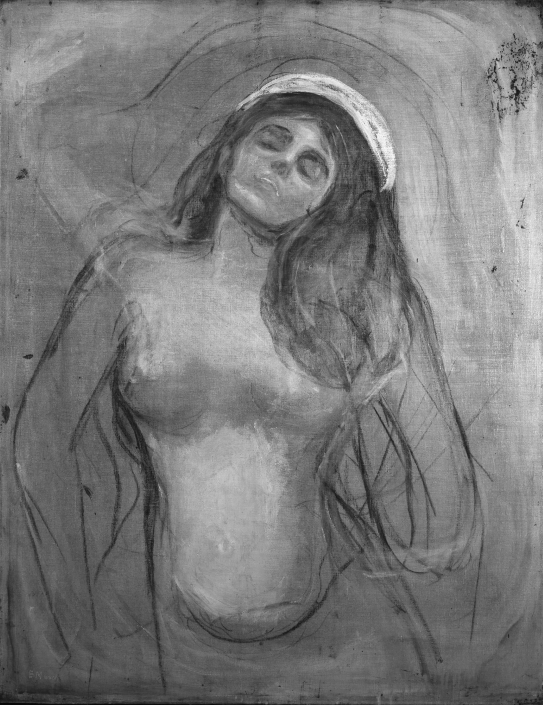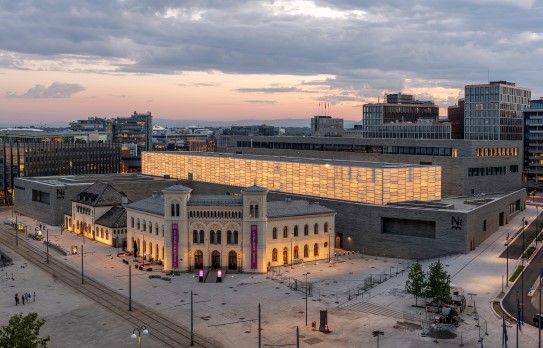Madonna’s secret

When Edvard Munch’s iconic painting Madonna was recently examined by a conservator and a photographer at the National Museum of Norway, they discovered something no one knew about: underneath the visible surface, an unknown sketch appeared.
Text by communications adviser Hanne Marie Willoch
The discovery gives new and valuable insight into how, and when, Munch made one of his most famous paintings.
The discovery was made by conservator Thierry Ford and photographer Børre Høstland at the National Museum by using infrared reflectography, a technique that allows conservators to see underlayers beneath the surface of paintings.
Madonna has undergone research and conservation in advance of going on display in the Munch Room in the National Museum’s new building, which opens in Oslo on 11 June 2022.
“Infrared reflectography is an imaging technique routinely used by conservators on paintings to ‘see beneath the surface’ and can reveal underlayers in a non-destructive way,” Ford explains. “Because paintings like Madonna and The Scream have been on permanent display for many years, the moving process to the new museum made it possible to conduct this kind of research.”
Attempted a different composition
The painting depicts a woman arching her back, with one arm behind her head and the other behind her back. Against a background of undulating, quivering lines, she is depicted with closed eyes and seems almost to be floating.
By using the infrared camera, which revealed hidden details underneath the top layer, Ford and Høstland discovered multiple sketch lines surrounding the woman’s left arm.
The underdrawings reveal that Munch attempted a different composition before finally settling on the position of the arms that he used for later Madonna paintings.
“The discovery was unexpected and exciting,” Ford recalls. “It also confirms that there is more to reveal in the museum’s Munch collection when it comes to his technique.”


New dating
Edvard Munch painted five similar-sized versions of Madonna between 1894 and 1897. None of the paintings were dated by Munch. The National Museum’s version has until now been thought to be from either 1894 or 1895. The exciting discovery of Munch’s corrections to the composition now supports earlier theories that the National Museum’s version is the very first one Munch painted.
“The new findings, together with earlier research, make it reasonable to determine that Edvard Munch finished this first version of Madonna in 1894,” says Vibeke Waallann Hansen, curator at the National Museum. “It also provides us with interesting information about how the artist worked on the composition. We can see that he experimented with letting both arms hang down. Along with other early sketches with similar motifs, the underdrawings in the painting tell us that he was hesitant about how to place the arms of his Madonna.”
A contradictory motif
The woman is a major and recurrent theme in Munch’s art, and his depictions of women are typically ambiguous and full of contradictions. The title Madonna, commonly associated with the mother of Jesus, contrasts both with the figure herself and with the painting’s alternative title, Elskende kvinde (Loving Woman). The figure has a halo, but it is red rather than gold, as it would be in a religious image.
“Edvard Munch’s representation of a woman making love was something very new and sensational in Norway,” Waallann Hansen notes. “There was no tradition for erotic motifs in Norwegian art in Munch’s time. When the painting was shown in Kristiania in 1895, it became the subject of fierce debate.”

Munch and the new National Museum
The National Museum holds a significant collection consisting of 57 paintings, such as The Scream, The Dance of Life, Melancholy – and Madonna, all of which will go on display in the new National Museum’s Munch Room when it opens to the public on 11 June 2022.
18 of the most famous paintings from the 1890s will be presented in the new Munch Room. Munch will also appear in other exhibition rooms throughout the museum in order to be put in an art-historical context.
Get a close encounter with Madonna in this live stream on December 12



